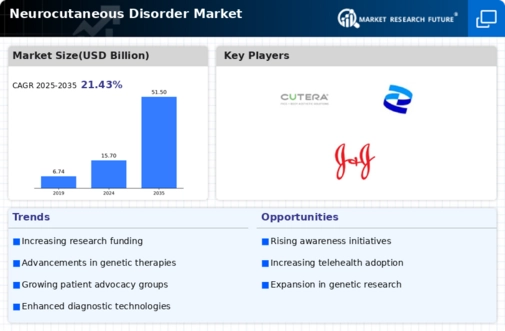Neurocutaneous Disorder Size
Neurocutaneous Disorder Market Growth Projections and Opportunities
Sturge-Weber syndrome, an uncommon congenital disorder characterized by leptomeningeal angiomas, a port-wine stain birthmark, and ocular complications, is witnessing significant growth propelled by several factors. The market is particularly influenced by the increasing prevalence of epilepsy and glaucoma, augmented research and development funding dedicated to rare diseases, and the escalating focus of key players on addressing Sturge-Weber syndrome globally.
Epilepsy and glaucoma are the predominant conditions associated with Sturge-Weber syndrome. Glaucoma, a condition wherein elevated eye pressure leads to damage to the optic nerve, affects approximately 45% of individuals diagnosed with Sturge-Weber syndrome. This dual association emphasizes the critical need for effective treatments and interventions targeting both epilepsy and glaucoma in patients with Sturge-Weber syndrome.
The global Sturge-Weber Syndrome market is poised for substantial growth, projected to register a Compound Annual Growth Rate (CAGR) of 5.3% during the forecast period spanning from 2018 to 2023. As of 2017, the market was predominantly led by the Americas, commanding a share of 37.1%, followed by Europe with 31.3%, and Asia Pacific with 23.1%. The robust growth in the Americas is attributed to well-established technological advancements, substantial healthcare expenditure, and the presence of key industry players actively contributing to research and development initiatives.
One of the primary driving forces behind the growth of the Sturge-Weber syndrome market is the increasing prevalence of epilepsy and glaucoma. Sturge-Weber syndrome is intricately linked to these conditions, making it imperative for healthcare providers and researchers to address the specific needs of affected individuals. The prevalence of glaucoma, in particular, underscores the significant impact of Sturge-Weber syndrome on ocular health, emphasizing the urgent requirement for targeted treatments and therapeutic advancements.
Additionally, the surge in research and development funding dedicated to rare diseases is playing a pivotal role in advancing the understanding of Sturge-Weber syndrome and developing innovative treatment modalities. The unique nature of rare diseases often necessitates specialized research initiatives, and the increasing funding directed towards Sturge-Weber syndrome reflects a growing recognition of the importance of addressing rare congenital disorders comprehensively.
Key players in the healthcare sector are redirecting their focus towards Sturge-Weber syndrome, acknowledging the specific challenges and complexities associated with this rare disorder. This strategic shift is fostering collaborations, research partnerships, and innovative approaches to diagnosis, treatment, and patient care. The concerted efforts of industry players are instrumental in driving progress within the Sturge-Weber syndrome market, ultimately benefiting affected individuals by improving treatment outcomes and enhancing overall quality of life.
While the market presents substantial growth opportunities, it is essential to recognize the multifaceted nature of Sturge-Weber syndrome and its impact on patients. Achieving advancements in diagnostics, therapeutic interventions, and patient management requires a collaborative approach, bringing together medical professionals, researchers, and industry stakeholders. Furthermore, the global distribution of market shares emphasizes the need for a comprehensive and inclusive strategy that considers regional variations in healthcare infrastructure, technological capabilities, and patient demographics.
In conclusion, the Sturge-Weber syndrome market is undergoing a transformative phase, driven by the increasing prevalence of associated conditions, heightened research and development funding, and the dedicated focus of key industry players. As efforts to address this rare congenital disorder intensify, the market is poised to witness sustained growth, with potential breakthroughs in diagnostics and therapeutics contributing to improved patient outcomes. The evolution of the Sturge-Weber syndrome market reflects a commitment to advancing rare disease research and underscores the importance of global collaboration to meet the unique healthcare needs of affected individuals.







Leave a Comment